Native RNA Purification Method for Small RNA Molecules Based on Asymmetrical Flow Field-Flow Fractionation
Abstract
:1. Introduction
2. Results
2.1. AF4 Separation of Short ssRNA and dsRNA Molecules
2.1.1. AF4 Set-Up for the Separation of sRNAs
2.1.2. Elution of 88- and 108-nt ssRNA Molecules
2.1.3. Mobile Phase Composition Affects ssRNA Elution
2.1.4. AF4 Provides Good Separation between Small ssRNA and dsRNA Molecules in Native Conditions
2.2. Purification of siRNA Molecules with AF4
2.2.1. AF4 Separates siRNAs and Partially Digested Dicer Reaction Products
2.2.2. AF4 Fractionation Separates siRNAs from Contaminating Reaction Components
2.2.3. Mobile Phase Influences Elution and siRNA Purification by AF4
2.3. Biological Properties of AF4-Purified siRNA Swarms
2.3.1. AF4 Purified siRNA Swarms Are Not Toxic for Mammalian Cells
2.3.2. AF4 Purified siRNA Swarms Retain Their Antiviral Activity
3. Discussion
4. Materials and Methods
4.1. Production and Purification of sRNA Molecules
4.1.1. Generation of sRNA Molecules
4.1.2. AF4 Setup and Operation
4.1.3. RNA Purification Using AEX
4.1.4. Analysis of Recovery, Quality and Quantity
4.1.5. RNase A Treatment
4.2. Functional Tests for AF4-Purified siRNA Molecules
4.2.1. Cells and Virus
4.2.2. Transfection
4.2.3. Cell Viability Assay
4.2.4. HSV-1 Infection and Plaque Assay
4.2.5. Statistical Analysis
5. Conclusions
Supplementary Materials
Author Contributions
Funding
Institutional Review Board Statement
Informed Consent Statement
Data Availability Statement
Acknowledgments
Conflicts of Interest
References
- Mattick, J.S.; Makunin, I.V. Small regulatory RNAs in mammals. Hum. Mol. Genet. 2005, 14, R121–R132. [Google Scholar] [CrossRef] [PubMed] [Green Version]
- Brosnan, C.A.; Voinnet, O. The long and the short of noncoding RNAs. Cur. Opin. Cell Biol. 2009, 21, 416–425. [Google Scholar] [CrossRef] [PubMed]
- Waters, L.S.; Storz, G. Regulatory RNAs in bacteria. Cell 2009, 136, 615–628. [Google Scholar] [CrossRef] [PubMed] [Green Version]
- Tycowski, K.T.; Guo, Y.E.; Lee, N.; Moss, W.N.; Vallery, T.K.; Xie, M.; Steitz, J.A. Viral noncoding RNAs: More surprises. Genes Dev. 2015, 29, 567–584. [Google Scholar] [CrossRef] [PubMed] [Green Version]
- Pawlica, P.; Yario, T.A.; White, S.; Wang, J.; Moss, W.N.; Hui, P.; Vinetz, J.M.; Steitz, J.A. SARS-CoV-2 expresses a microRNA-like small RNA able to selectively repress host genes. Proc. Natl. Acad. Sci. USA 2021, 118, e2116668118. [Google Scholar] [CrossRef] [PubMed]
- Isakova, A.; Fehlmann, T.; Keller, A.; Quake, S.R. A mouse tissue atlas of small noncoding RNA. Proc. Natl. Acad. Sci. USA 2020, 117, 25634–25645. [Google Scholar] [CrossRef]
- Matera, A.G.; Terns, R.M.; Terns, M.P. Non-coding RNAs: Lessons from the small nuclear and small nucleolar RNAs. Nat. Rev. Mol. Cell Biol. 2007, 8, 209–220. [Google Scholar] [CrossRef]
- Farazi, T.A.; Juranek, S.A.; Tuschl, T. The growing catalog of small RNAs and their association with distinct Argonaute/Piwi family members. Development 2008, 135, 1201–1214. [Google Scholar] [CrossRef] [Green Version]
- Macrae, I.J.; Zhou, K.; Li, F.; Repic, A.; Brooks, A.N.; Cande, W.Z.; Adams, P.D.; Doudna, J.A. Structural basis for double-stranded RNA processing by Dicer. Science 2006, 311, 195–198. [Google Scholar] [CrossRef] [Green Version]
- Axtell, M.J. Classification and comparison of small RNAs from plants. Ann. Rev. Plant Biol. 2013, 64, 137–159. [Google Scholar] [CrossRef] [Green Version]
- Zhang, H.; Kolb, F.A.; Brondani, V.; Billy, E.; Filipowicz, W. Human Dicer preferentially cleaves dsRNAs at their termini without a requirement for ATP. EMBO J. 2002, 21, 5875–5885. [Google Scholar] [CrossRef] [PubMed] [Green Version]
- Kloosterman, W.P.; Plasterk, R.H. The diverse functions of microRNAs in animal development and disease. Dev. Cell 2006, 11, 441–450. [Google Scholar] [CrossRef] [PubMed] [Green Version]
- Condorelli, G.; Dimmeler, S. MicroRNAs: Components of an integrated system controlling cardiac development, physiology, and disease pathogenesis. Cardiovasc. Res. 2008, 79, 551–552. [Google Scholar] [CrossRef] [PubMed] [Green Version]
- Friedman, J.M.; Jones, P.A. MicroRNAs: Critical mediators of differentiation, development and disease. Swiss Med. Wkly. 2009, 139, 466–472. [Google Scholar]
- Sayed, D.; Abdellatif, M. MicroRNAs in development and disease. Physiol. Rev. 2011, 91, 827–887. [Google Scholar] [CrossRef]
- Ameis, D.; Khoshgoo, N.; Iwasiow, B.M.; Snarr, P.; Keijzer, R. MicroRNAs in lung development and disease. Paediatr. Respir. Rev. 2017, 22, 38–43. [Google Scholar] [CrossRef]
- Levanova, A.; Poranen, M.M. RNA interference as a prospective tool for the control of human viral infections. Front. Microbiol. 2018, 9, 2151. [Google Scholar] [CrossRef]
- Feng, R.; Patil, S.; Zhao, X.; Miao, Z.; Qian, A. RNA therapeutics—Research and clinical advancements. Front. Mol. Biosci. 2021, 8, 710738. [Google Scholar] [CrossRef]
- Talap, J.; Zhao, J.; Shen, M.; Song, Z.; Zhou, H.; Kang, Y.; Sun, L.; Yu, L.; Zeng, S.; Cai, S. Recent advances in therapeutic nucleic acids and their analytical methods. J. Pharm. Biomed. Anal. 2021, 206, 114368. [Google Scholar] [CrossRef]
- Kari, I.; Syrjanen, S.; Johansson, B.; Peri, P.; He, B.; Roizman, B.; Hukkanen, V. Antisense RNA directed to the human papillomavirus type 16 E7 mRNA from herpes simplex virus type 1 derived vectors is expressed in CaSki cells and downregulates E7 mRNA. Virol. J. 2007, 4, 47. [Google Scholar] [CrossRef] [Green Version]
- Chaudhary, K.; Nagpal, G.; Dhanda, S.K.; Raghava, G.P. Prediction of immunomodulatory potential of an RNA sequence for designing non-toxic siRNAs and RNA-based vaccine adjuvants. Sci. Rep. 2016, 6, 20678. [Google Scholar] [CrossRef] [PubMed] [Green Version]
- Pastor, F.; Berraondo, P.; Etxeberria, I.; Frederick, J.; Sahin, U.; Gilboa, E.; Melero, I. An RNA toolbox for cancer immunotherapy. Nat. Rev. Drug Discov. 2018, 17, 751–767. [Google Scholar] [CrossRef] [PubMed]
- Beaucage, S.L. Solid-phase synthesis of siRNA oligonucleotides. Cur. Opin. Drug Discov. Devel. 2008, 11, 203–216. [Google Scholar]
- Sohail, M.; Doran, G.; Riedemann, J.; Macaulay, V.; Southern, E.M. A simple and cost-effective method for producing small interfering RNAs with high efficacy. Nucleic Acids Res. 2003, 31, e38. [Google Scholar] [CrossRef] [Green Version]
- Milligan, J.F.; Groebe, D.R.; Witherell, G.W.; Uhlenbeck, O.C. Oligoribonucleotide synthesis using T7 RNA polymerase and synthetic DNA templates. Nucleic Acids Res. 1987, 15, 8783–8798. [Google Scholar] [CrossRef] [PubMed] [Green Version]
- Brown, J.E.; Klement, J.F.; McAllister, W.T. Sequences of three promoters for the bacteriophage SP6 RNA polymerase. Nucleic Acids Res. 1986, 14, 3521–3526. [Google Scholar] [CrossRef] [PubMed] [Green Version]
- Stump, W.T.; Hall, K.B. SP6 RNA polymerase efficiently synthesizes RNA from short double-stranded DNA templates. Nucleic Acids Res. 1993, 21, 5480–5484. [Google Scholar] [CrossRef] [Green Version]
- Kim, D.H.; Longo, M.; Han, Y.; Lundberg, P.; Cantin, E.; Rossi, J.J. Interferon induction by siRNAs and ssRNAs synthesized by phage polymerase. Nat. Biotechnol. 2004, 22, 321–325. [Google Scholar] [CrossRef]
- Aalto, A.P.; Sarin, L.P.; van Dijk, A.A.; Saarma, M.; Poranen, M.M.; Arumae, U.; Bamford, D.H. Large-scale production of dsRNA and siRNA pools for RNA interference utilizing bacteriophage phi6 RNA-dependent RNA polymerase. RNA 2007, 13, 422–429. [Google Scholar] [CrossRef] [Green Version]
- Makeyev, E.V.; Bamford, D.H. Replicase activity of purified recombinant protein P2 of double-stranded RNA bacteriophage phi6. EMBO J. 2000, 19, 124–133. [Google Scholar] [CrossRef]
- Romanovskaya, A.; Paavilainen, H.; Nygardas, M.; Bamford, D.H.; Hukkanen, V.; Poranen, M.M. Enzymatically produced pools of canonical and Dicer-substrate siRNA molecules display comparable gene silencing and antiviral activities against herpes simplex virus. PLoS ONE 2012, 7, e51019. [Google Scholar] [CrossRef] [PubMed] [Green Version]
- Nygardas, M.; Vuorinen, T.; Aalto, A.P.; Bamford, D.H.; Hukkanen, V. Inhibition of coxsackievirus B3 and related enteroviruses by antiviral short interfering RNA pools produced using phi6 RNA-dependent RNA polymerase. J. Gen. Virol. 2009, 90, 2468–2473. [Google Scholar] [CrossRef] [PubMed]
- Shanagar, J. Purification of a synthetic oligonucleotide by anion exchange chromatography: Method optimisation and scale-up. J. Biochem. Biophys. Methods 2005, 64, 216–225. [Google Scholar] [CrossRef] [PubMed]
- Srivatsa, G.S.; Klopchin, P.; Batt, M.; Feldman, M.; Carlson, R.H.; Cole, D.L. Selectivity of anion exchange chromatography and capillary gel electrophoresis for the analysis of phosphorothioate oligonucleotides. J. Pharm. Biomed. Anal. 1997, 16, 619–630. [Google Scholar] [CrossRef]
- Thayer, J.R.; Flook, K.J.; Woodruff, A.; Rao, S.; Pohl, C.A. New monolith technology for automated anion-exchange purification of nucleic acids. J. Chromatogr. B Analyt. Technol. Biomed. Life Sci. 2010, 878, 933–941. [Google Scholar] [CrossRef]
- Waghmare, S.P.; Pousinis, P.; Hornby, D.P.; Dickman, M.J. Studying the mechanism of RNA separations using RNA chromatography and its application in the analysis of ribosomal RNA and RNA:RNA interactions. J. Chromatogr. A 2009, 1216, 1377–1382. [Google Scholar] [CrossRef]
- Kanwal, F.; Lu, C. A review on native and denaturing purification methods for non-coding RNA (ncRNA). J. Chromatogr. B Analyt. Technol. Biomed. Life Sci. 2019, 1120, 71–79. [Google Scholar] [CrossRef]
- Maniatis, T.; Jeffrey, A.; van deSande, H. Chain length determination of small double- and single-stranded DNA molecules by polyacrylamide gel electrophoresis. Biochemistry 1975, 14, 3787–3794. [Google Scholar] [CrossRef]
- Petrov, A.; Wu, T.; Puglisi, E.V.; Puglisi, J.D. RNA purification by preparative polyacrylamide gel electrophoresis. Meth. Enzymol. 2013, 530, 315–330. [Google Scholar] [CrossRef]
- Uhlenbeck, O.C. Keeping RNA happy. RNA 1995, 1, 4–6. [Google Scholar]
- Martins, R.; Queiroz, J.A.; Sousa, F. Ribonucleic acid purification. J. Chromatogr. A 2014, 1355, 1–14. [Google Scholar] [CrossRef] [PubMed]
- Baronti, L.; Karlsson, H.; Marušič, M.; Petzold, K. A guide to large-scale RNA sample preparation. Anal. Bioanal. Chem. 2018, 410, 3239–3252. [Google Scholar] [CrossRef] [PubMed] [Green Version]
- Cheong, H.K.; Hwang, E.; Lee, C.; Choi, B.S.; Cheong, C. Rapid preparation of RNA samples for NMR spectroscopy and X-ray crystallography. Nucleic Acids Res. 2004, 32, e84. [Google Scholar] [CrossRef] [PubMed] [Green Version]
- Batey, R.T.; Kieft, J.S. Improved native affinity purification of RNA. RNA 2007, 13, 1384–1389. [Google Scholar] [CrossRef] [Green Version]
- Kieft, J.S.; Batey, R.T. A general method for rapid and nondenaturing purification of RNAs. RNA 2004, 10, 988–995. [Google Scholar] [CrossRef] [Green Version]
- Kim, I.; McKenna, S.A.; Viani Puglisi, E.; Puglisi, J.D. Rapid purification of RNAs using fast performance liquid chromatography (FPLC). RNA 2007, 13, 289–294. [Google Scholar] [CrossRef] [Green Version]
- Lukavsky, P.J.; Puglisi, J.D. Large-scale preparation and purification of polyacrylamide-free RNA oligonucleotides. RNA 2004, 10, 889–893. [Google Scholar] [CrossRef] [Green Version]
- McCarthy, S.M.; Gilar, M.; Gebler, J. Reversed-phase ion-pair liquid chromatography analysis and purification of small interfering RNA. Anal. Biochem. 2009, 390, 181–188. [Google Scholar] [CrossRef]
- Romanovskaya, A.; Sarin, L.P.; Bamford, D.H.; Poranen, M.M. High-throughput purification of double-stranded RNA molecules using convective interaction media monolithic anion exchange columns. J. Chromatogr. A 2013, 1278, 54–60. [Google Scholar] [CrossRef]
- Litzén, A.; Wahlund, K.G. Improved separation speed and efficiency for proteins, nucleic acids and viruses in asymmetrical flow field flow fractionation. J. Chromatogr. 1989, 476, 413–421. [Google Scholar] [CrossRef]
- Liu, M.K.; Giddings, J.C. Separation and measurement of diffusion coefficients of linear and circular DNAs by flow field-flow fractionation. Macromolecules 1993, 26, 3576–3588. [Google Scholar] [CrossRef]
- Wahlund, K.G.; Litzén, A. Application of an asymmetrical flow field-flow fractionation channel to the separation and characterization of proteins, plasmids, plasmid fragments, polysaccharides and unicellular algae. J. Chromatogr. 1989, 461, 73–87. [Google Scholar] [CrossRef]
- Wang, L.; Lee, J.Y.; Gao, L.; Yin, J.; Duan, Y.; Jimenez, L.A.; Adkins, G.B.; Ren, W.; Li, L.; Fang, J.; et al. A DNA aptamer for binding and inhibition of DNA methyltransferase 1. Nucleic Acids Res. 2019, 47, 11527–11537. [Google Scholar] [CrossRef] [PubMed] [Green Version]
- Andersson, C.I.; Arfvidsson, C.; Kallio, P.T.; Wahlund, K.G.; Bülow, L. Enhanced ribosome and tRNA contents in Escherichia coli expressing a truncated Vitreoscilla hemoglobin mutant analyzed by flow field-flow fractionation. Biotechnol. Lett. 2003, 25, 1499–1504. [Google Scholar] [CrossRef]
- Nilsson, M.; Kallio, P.T.; Bailey, J.E.; Bülow, L.; Wahlund, K.G. Expression of Vitreoscilla hemoglobin in Escherichia coli enhances ribosome and tRNA levels: A flow field-flow fractionation study. Biotechnol. Prog. 1999, 15, 158–163. [Google Scholar] [CrossRef]
- Zhang, J.; Haas, R.M.; Leone, A.M. Polydispersity characterization of lipid nanoparticles for siRNA delivery using multiple detection size-exclusion chromatography. Anal. Chem. 2012, 84, 6088–6096. [Google Scholar] [CrossRef]
- Mildner, R.; Hak, S.; Parot, J.; Hyldbakk, A.; Borgos, S.E.; Some, D.; Johann, C.; Caputo, F. Improved multidetector asymmetrical-flow field-flow fractionation method for particle sizing and concentration measurements of lipid-based nanocarriers for RNA delivery. Eur. J. Pharm. Biopharm. 2021, 163, 252–265. [Google Scholar] [CrossRef]
- Ashby, J.; Flack, K.; Jimenez, L.A.; Duan, Y.; Khatib, A.K.; Somlo, G.; Wang, S.E.; Cui, X.; Zhong, W. Distribution profiling of circulating microRNAs in serum. Anal. Chem. 2014, 86, 9343–9349. [Google Scholar] [CrossRef] [Green Version]
- Jiang, M.; Österlund, P.; Sarin, L.P.; Poranen, M.M.; Bamford, D.H.; Guo, D.; Julkunen, I. Innate immune responses in human monocyte-derived dendritic cells are highly dependent on the size and the 5′ phosphorylation of RNA molecules. J. Immunol. 2011, 187, 1713–1721. [Google Scholar] [CrossRef]
- Jiang, M.; Österlund, P.; Westenius, V.; Guo, D.; Poranen, M.M.; Bamford, D.H.; Julkunen, I. Efficient inhibition of avian and seasonal influenza A viruses by a virus-specific Dicer-substrate small interfering RNA swarm in human monocyte-derived macrophages and dendritic cells. J. Virol. 2019, 93, e01916-18. [Google Scholar] [CrossRef] [Green Version]
- Paavilainen, H.; Lehtinen, J.; Romanovskaya, A.; Nygårdas, M.; Bamford, D.H.; Poranen, M.M.; Hukkanen, V. Inhibition of clinical pathogenic herpes simplex virus 1 strains with enzymatically created siRNA pools. J. Med. Virol. 2016, 88, 2196–2205. [Google Scholar] [CrossRef] [PubMed]
- Paavilainen, H.; Lehtinen, J.; Romanovskaya, A.; Nygårdas, M.; Bamford, D.H.; Poranen, M.M.; Hukkanen, V. Topical treatment of herpes simplex virus infection with enzymatically created siRNA swarm. Antivir. Ther. 2017, 22, 631–637. [Google Scholar] [CrossRef] [PubMed] [Green Version]
- Levanova, A.A.; Kalke, K.M.; Lund, L.M.; Sipari, N.; Sadeghi, M.; Nyman, M.C.; Paavilainen, H.; Hukkanen, V.; Poranen, M.M. Enzymatically synthesized 2′-fluoro-modified Dicer-substrate siRNA swarms against herpes simplex virus demonstrate enhanced antiviral efficacy and low cytotoxicity. Antivir. Res. 2020, 182, 104916. [Google Scholar] [CrossRef] [PubMed]
- Abels, J.A.; Moreno-Herrero, F.; van der Heijden, T.; Dekker, C.; Dekker, N.H. Single-molecule measurements of the persistence length of double-stranded RNA. Biophys. J. 2005, 88, 2737–2744. [Google Scholar] [CrossRef] [PubMed] [Green Version]
- Hyeon, C.; Dima, R.I.; Thirumalai, D. Size, shape, and flexibility of RNA structures. J. Chem. Phys. 2006, 125, 194905. [Google Scholar] [CrossRef] [Green Version]
- Pontié, M. Effect of aging on UF membranes by a streaming potential (SP) method. J. Membr. Sci. 1999, 154, 213–220. [Google Scholar] [CrossRef]
- Ashby, J.; Schachermeyer, S.; Duan, Y.; Jimenez, L.A.; Zhong, W. Probing and quantifying DNA-protein interactions with asymmetrical flow field-flow fractionation. J. Chromatogr. A 2014, 1358, 217–224. [Google Scholar] [CrossRef] [Green Version]
- Draper, D.E. A guide to ions and RNA structure. RNA 2004, 10, 335–343. [Google Scholar] [CrossRef] [Green Version]
- Wagner, M.; Pietsch, C.; Tauhardt, L.; Schallon, A.; Schubert, U.S. Characterization of cationic polymers by asymmetric flow field-flow fractionation and multi-angle light scattering – a comparison with traditional techniques. J. Chromatogr. A 2014, 1325, 195–203. [Google Scholar] [CrossRef]
- Tinoco, I., Jr.; Bustamante, C. How RNA folds. J. Mol. Biol. 1999, 293, 271–281. [Google Scholar] [CrossRef]
- Barlow, J.J.; Mathias, A.P.; Williamson, R.; Gammack, D.B. A simple method for the quantitative isolation of undegraded high molecular weight ribonucleic acid. Biochem. Biophys. Res. Commun. 1963, 13, 61–66. [Google Scholar] [CrossRef]
- Wang, Q.; Carmichael, G.G. Effects of length and location on the cellular response to double-stranded RNA. Microbiol. Mol. Biol. Rev. 2004, 68, 432–452. [Google Scholar] [CrossRef] [Green Version]
- Wang, W.; Wang, W.H.; Azadzoi, K.M.; Su, N.; Dai, P.; Sun, J.; Wang, Q.; Liang, P.; Zhang, W.; Lei, X.; et al. Activation of innate antiviral immune response via double-stranded RNA-dependent RLR receptor-mediated necroptosis. Sci. Rep. 2016, 6, 22550. [Google Scholar] [CrossRef]
- Paavilainen, H.; Romanovskaya, A.; Nygårdas, M.; Bamford, D.H.; Poranen, M.M.; Hukkanen, V. Innate responses to small interfering RNA pools inhibiting herpes simplex virus infection in astrocytoid and epithelial cells. Innate Immun. 2015, 21, 349–357. [Google Scholar] [CrossRef] [Green Version]
- Gottlieb, P.; Strassman, J.; Qiao, X.; Frilander, M.; Frucht, A.; Mindich, L. In vitro packaging and replication of individual genomic segments of bacteriophage phi6 RNA. J. Virol. 1992, 66, 2611–2616. [Google Scholar] [CrossRef] [Green Version]
- Vidaver, A.K.; Koski, R.K.; Van Etten, J.L. Bacteriophage phi6: A lipid-containing virus of Pseudomonas phaseolicola. J. Virol. 1973, 11, 799–805. [Google Scholar] [CrossRef] [Green Version]
- Bamford, D.H.; Ojala, P.M.; Frilander, M.; Walin, L.; Bamford, J.K.H. Isolation, purification, and function of assembly intermediates and subviral particles of bacteriophages PRD1 and phi6. In Methods in Molecular Genetics; Academic Press: San Diego, CA, USA, 1995; Volume 6, pp. 455–474. [Google Scholar]
- Eskelin, K.; Lampi, M.; Meier, F.; Moldenhauer, E.; Bamford, D.H.; Oksanen, H.M. Asymmetric flow field flow fractionation methods for virus purification. J. Chromatogr. A 2016, 1469, 108–119. [Google Scholar] [CrossRef] [Green Version]
- Kalke, K.; Lund, L.; Nyman, M.; Levanova, A.A.; Urtti, A.; Poranen, M.M.; Hukkanen, V.; Paavilainen, H. Swarms of chemically modified antiviral siRNA targeting herpes simplex virus infection in human corneal epithelial cells. PLoS Pathog, 2022; submitted. [Google Scholar]
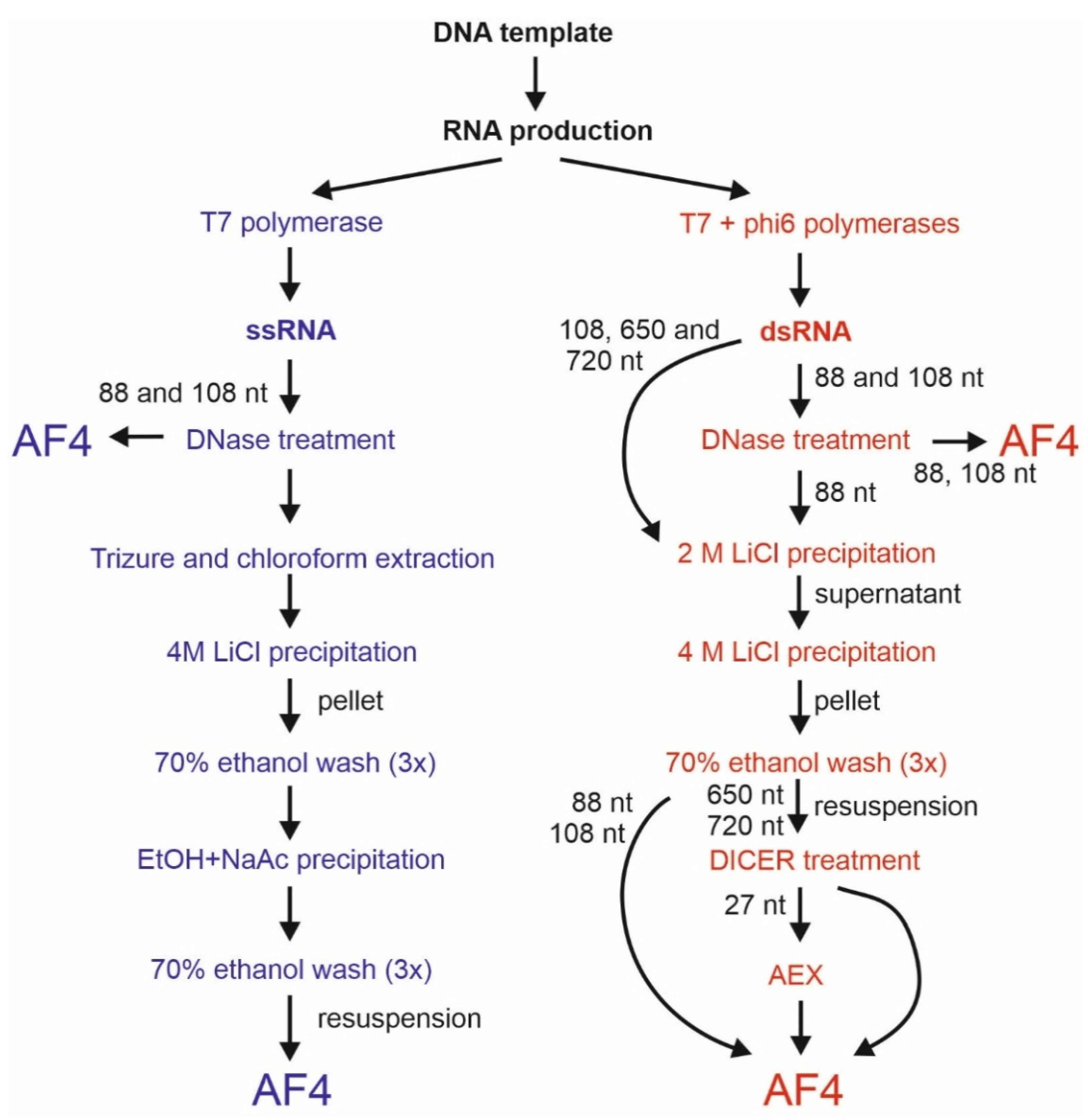
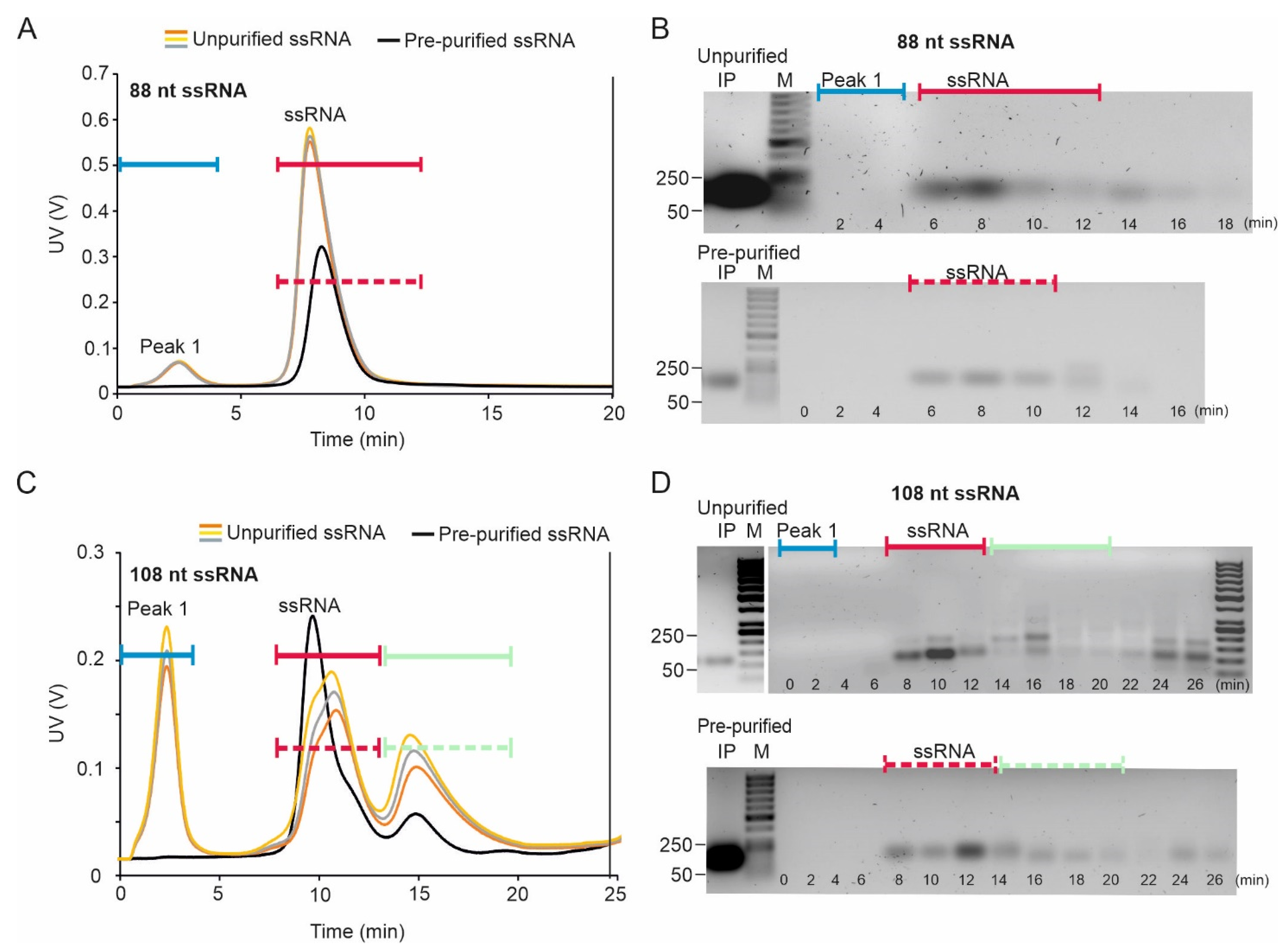
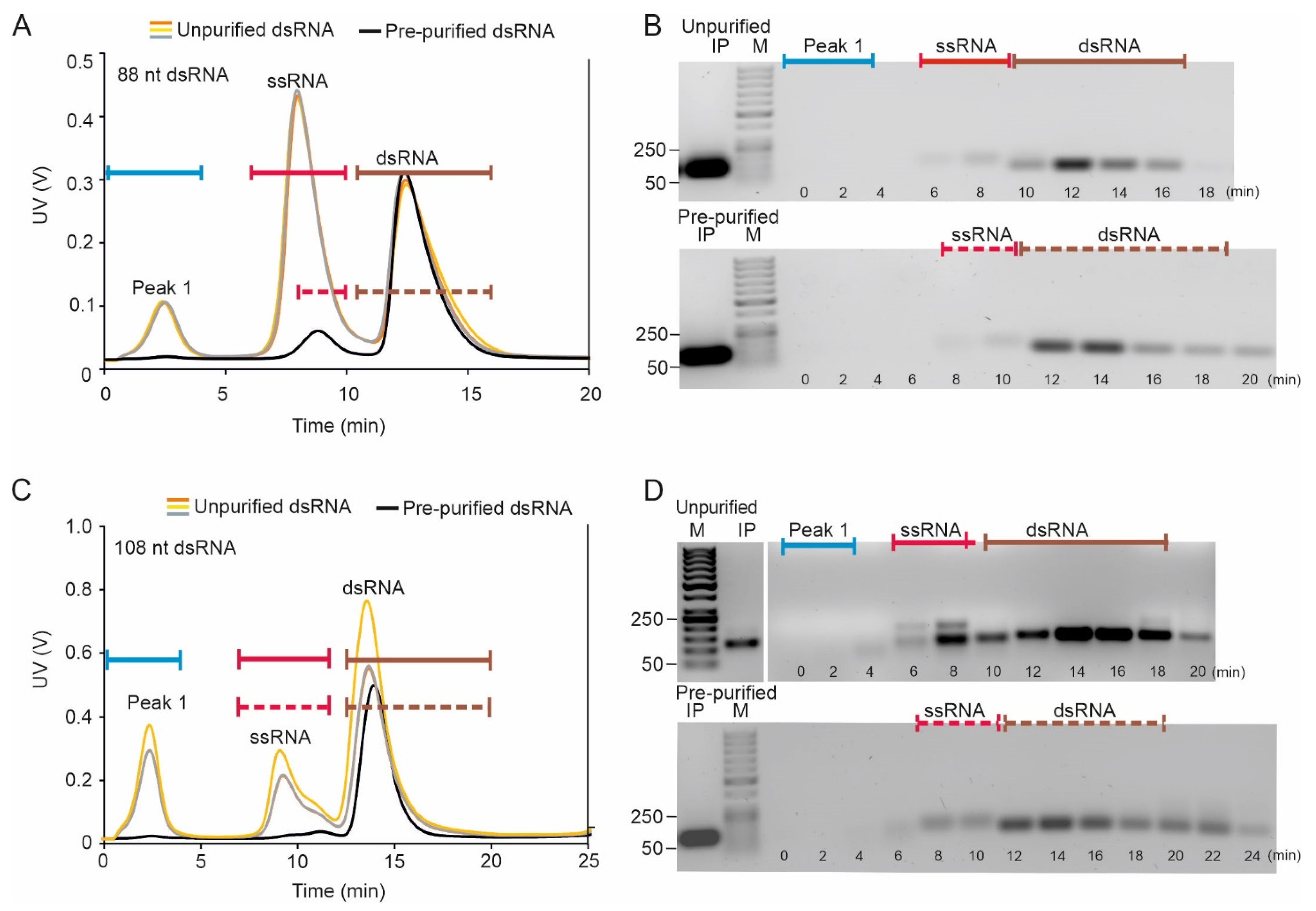
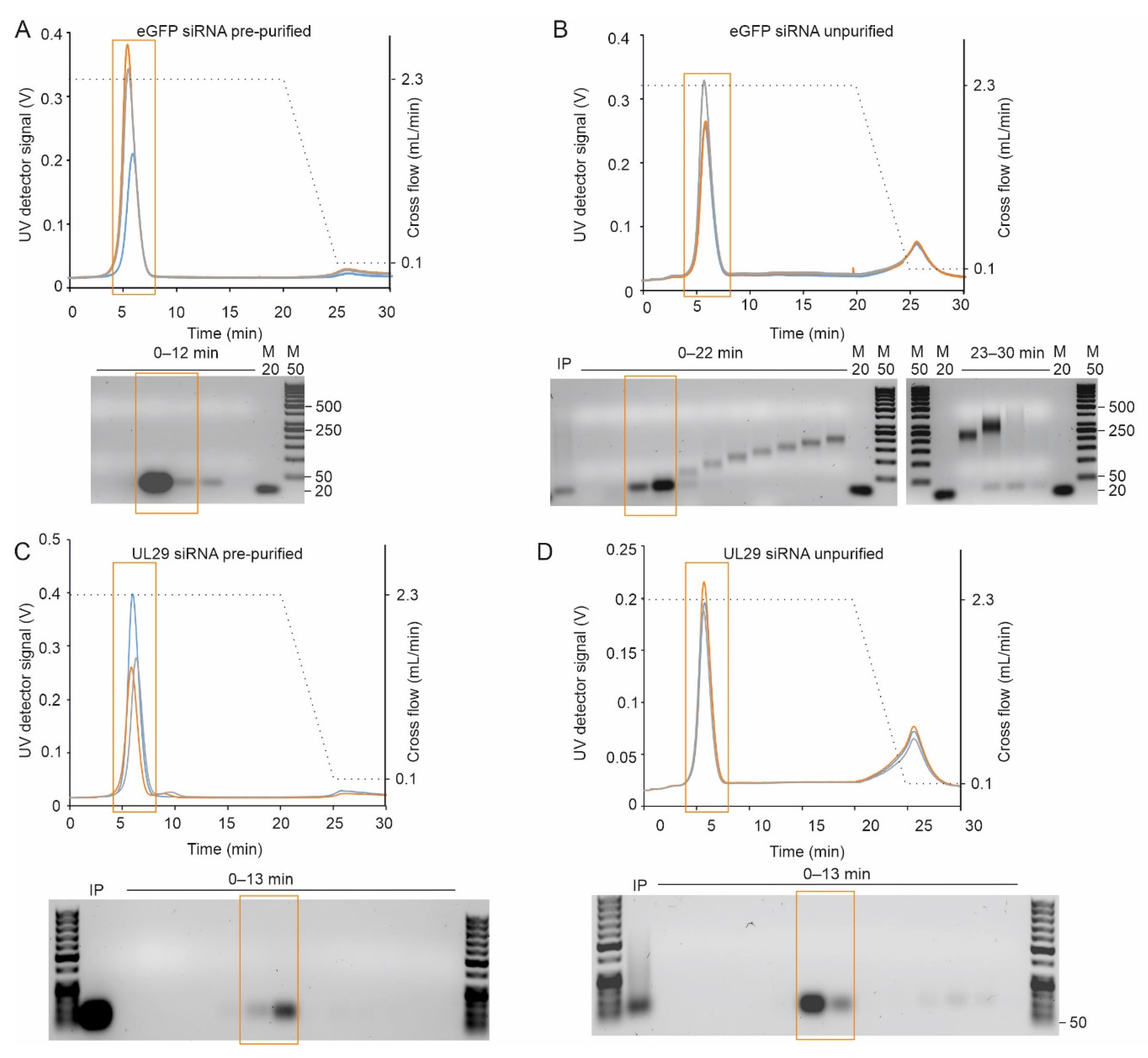
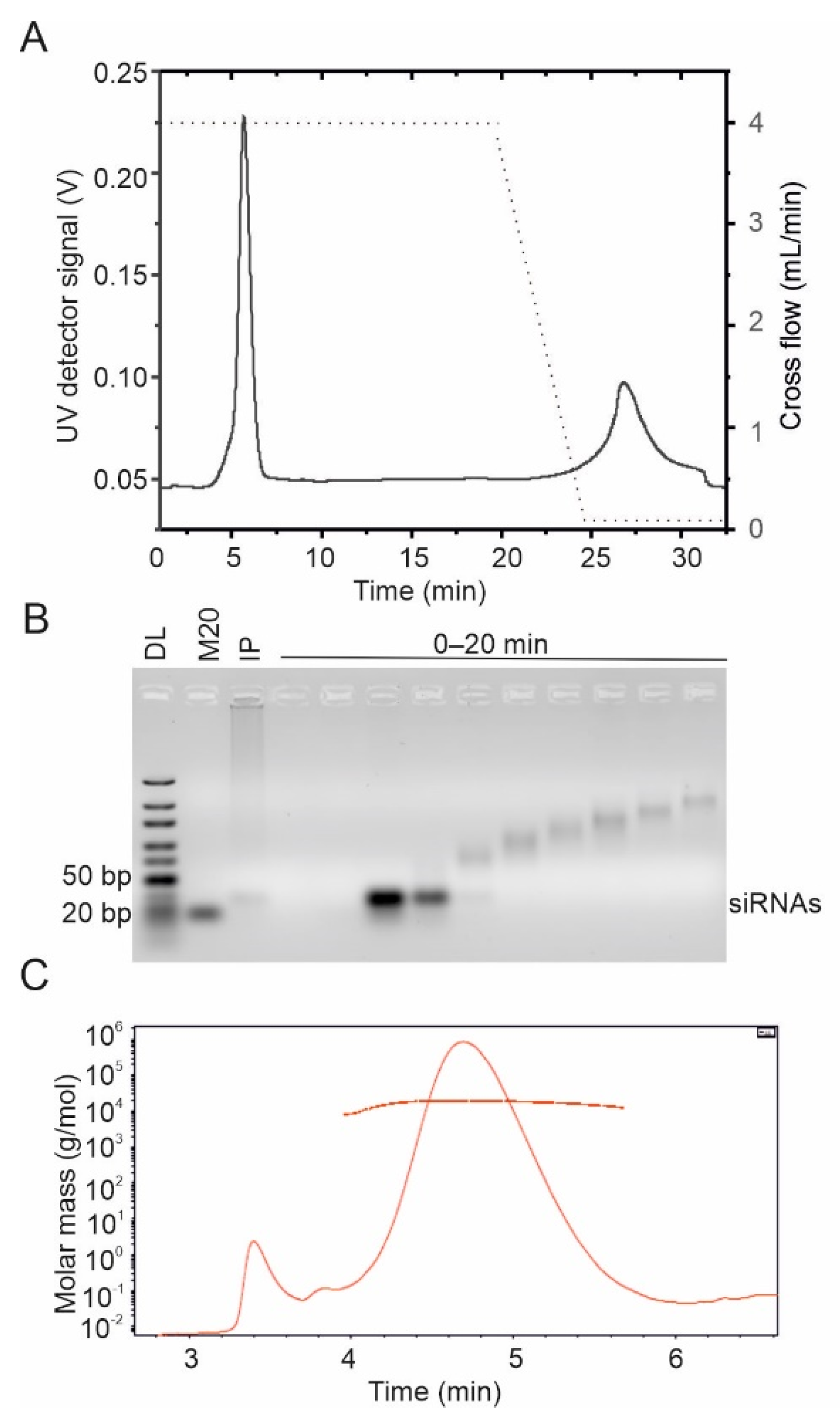
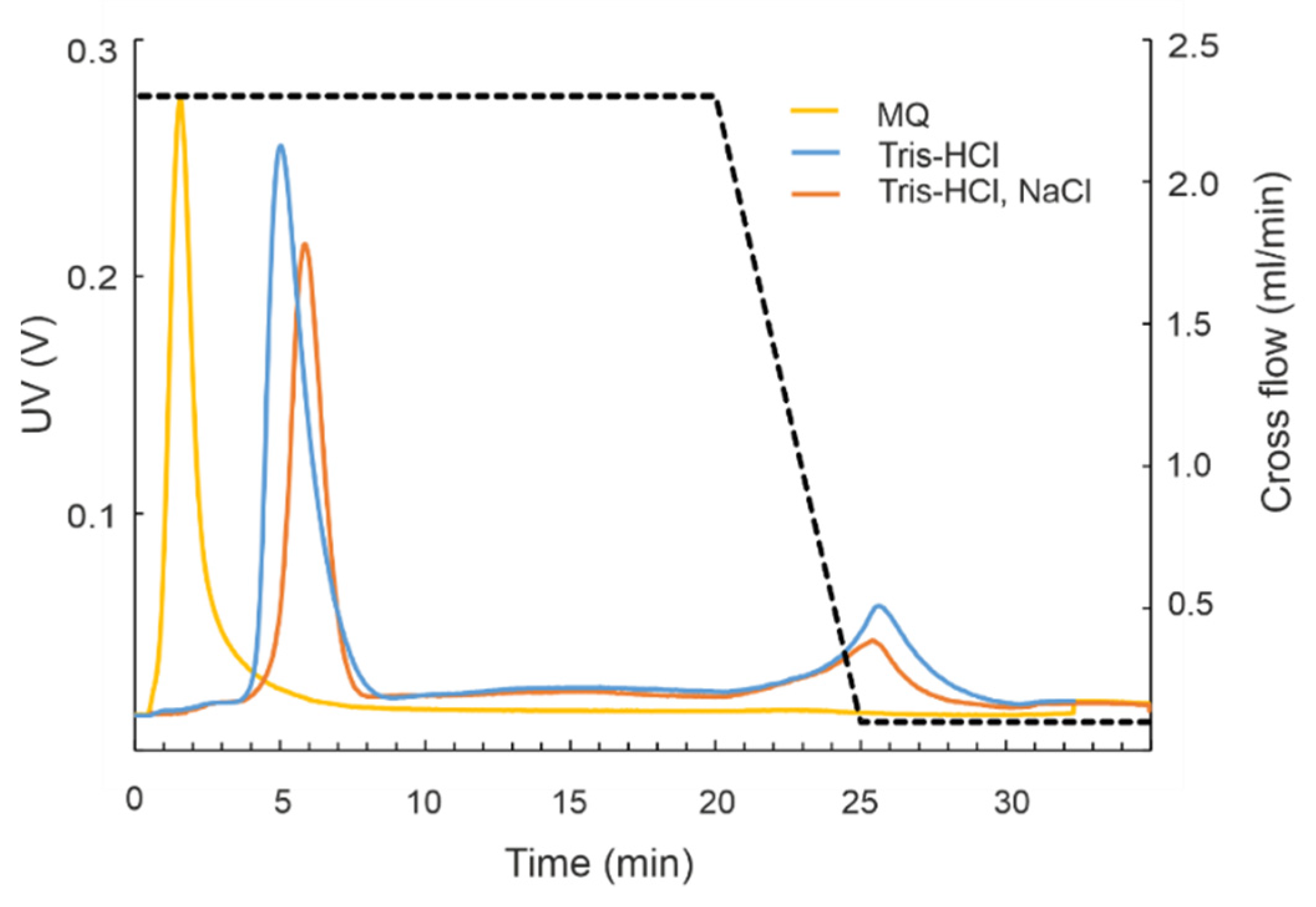
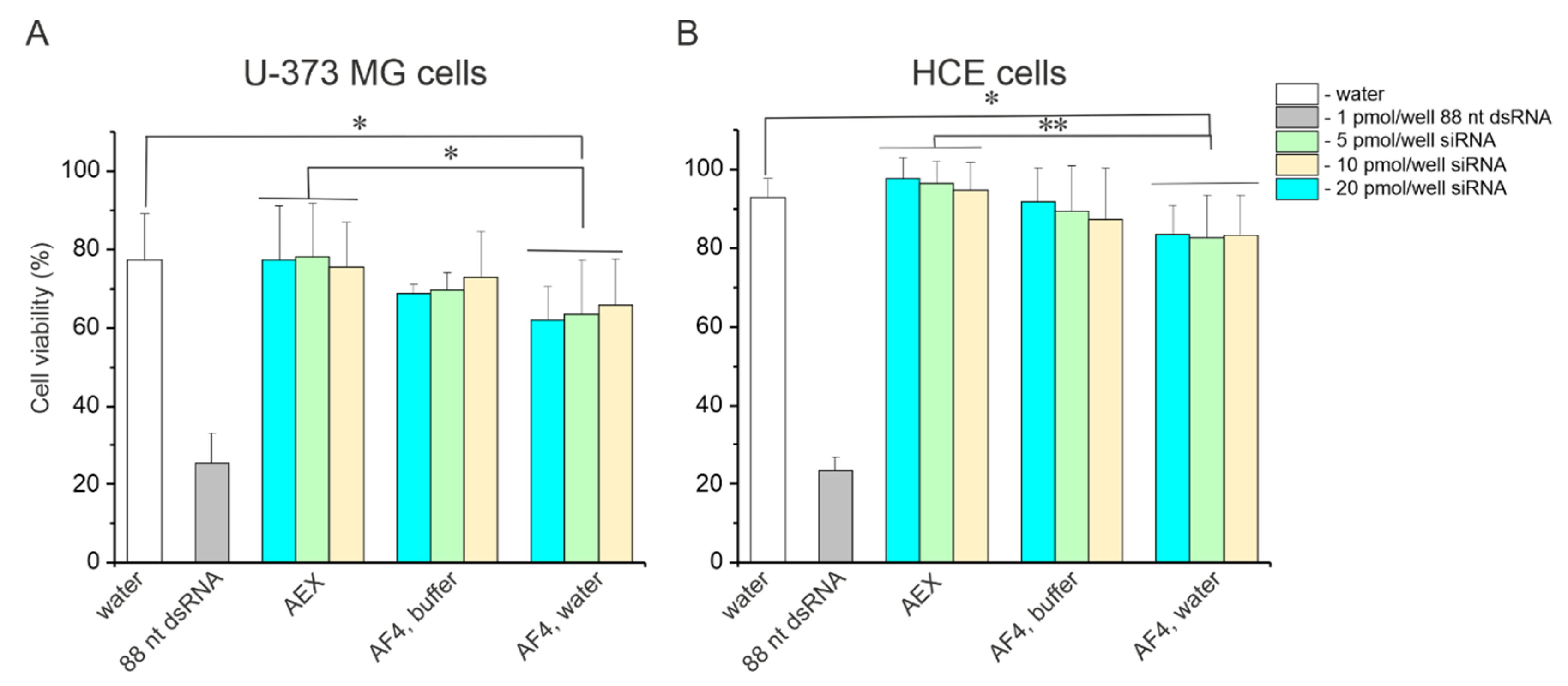
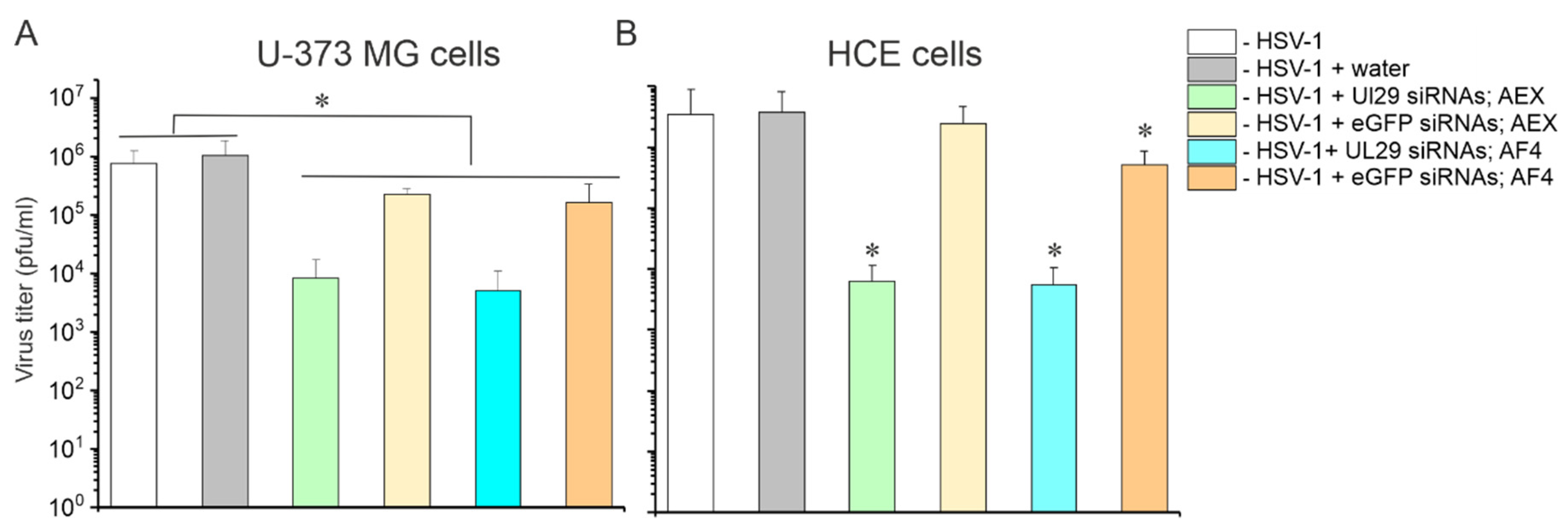
| Length (nt) | Type | Mw (kDa) 1 | GC (%) | Number of Predicted Secondary Structures 2 | Base Paired Regions in the Predicted Structure | Gibbs Energy Range (kcal/mol) | Predicted Length (nm) 3 | Predicted Rg (nm) 4 |
|---|---|---|---|---|---|---|---|---|
| 27 | siRNA | 17.3 | 1 | 25 | ~7 | |||
| 88 | ssRNA | 31.9 | 50.5 | 2 | 18–20 | −43.4–(−)42.3 | ~2.6–2.7 | |
| 88 | dsRNA | 63.8 | 1 | 88 | ~26 | |||
| 108 | ssRNA | 35.7 | 50.9 | 8 | 15–33 | −52.1–(−)49.6 | ~2.4–3.1 | |
| 108 | dsRNA | 71.8 | 1 | 108 | ~31 |
Publisher’s Note: MDPI stays neutral with regard to jurisdictional claims in published maps and institutional affiliations. |
© 2022 by the authors. Licensee MDPI, Basel, Switzerland. This article is an open access article distributed under the terms and conditions of the Creative Commons Attribution (CC BY) license (https://creativecommons.org/licenses/by/4.0/).
Share and Cite
Levanova, A.A.; Lampi, M.; Kalke, K.; Hukkanen, V.; Poranen, M.M.; Eskelin, K. Native RNA Purification Method for Small RNA Molecules Based on Asymmetrical Flow Field-Flow Fractionation. Pharmaceuticals 2022, 15, 261. https://doi.org/10.3390/ph15020261
Levanova AA, Lampi M, Kalke K, Hukkanen V, Poranen MM, Eskelin K. Native RNA Purification Method for Small RNA Molecules Based on Asymmetrical Flow Field-Flow Fractionation. Pharmaceuticals. 2022; 15(2):261. https://doi.org/10.3390/ph15020261
Chicago/Turabian StyleLevanova, Alesia A., Mirka Lampi, Kiira Kalke, Veijo Hukkanen, Minna M. Poranen, and Katri Eskelin. 2022. "Native RNA Purification Method for Small RNA Molecules Based on Asymmetrical Flow Field-Flow Fractionation" Pharmaceuticals 15, no. 2: 261. https://doi.org/10.3390/ph15020261
APA StyleLevanova, A. A., Lampi, M., Kalke, K., Hukkanen, V., Poranen, M. M., & Eskelin, K. (2022). Native RNA Purification Method for Small RNA Molecules Based on Asymmetrical Flow Field-Flow Fractionation. Pharmaceuticals, 15(2), 261. https://doi.org/10.3390/ph15020261







